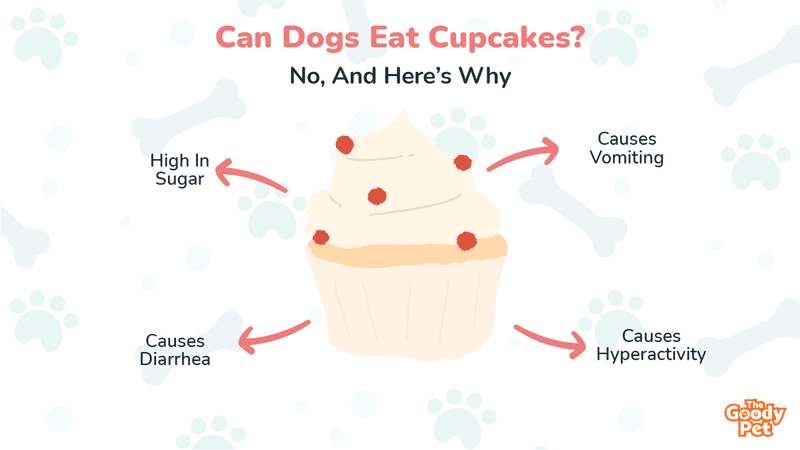Speaking of a birthday party and cupcakes will be among the first things that come into people’s minds. These fluffy, tasty snacks have slowly become an irreplaceable component for special occasions. Our love for them is immense, and we more often look up to a moment that presents an opportunity to bring us together. But can dogs eat cupcakes?
Yes, dogs can eat cupcakes, but for health’s sake, they should not. Cupcakes made for humans are usually high in sugar. As such, they will attract digestive issues in dogs in the short term, especially when dogs eat a great deal of them.
Human cupcakes are nothing less than heavenly and are usually non-toxic to dogs themselves. However, they don’t feature on the list of things dogs should eat. So, what makes them a no-no snack for our canines? What is in them that makes them unsuitable for dogs? Can they hurt dogs? What should you do when your dog eats them?
Now, we have answers to all these questions and more. Join us as we seek to find out why cupcakes and dogs don’t make good friends.
Are Cupcakes Okay For Dogs?
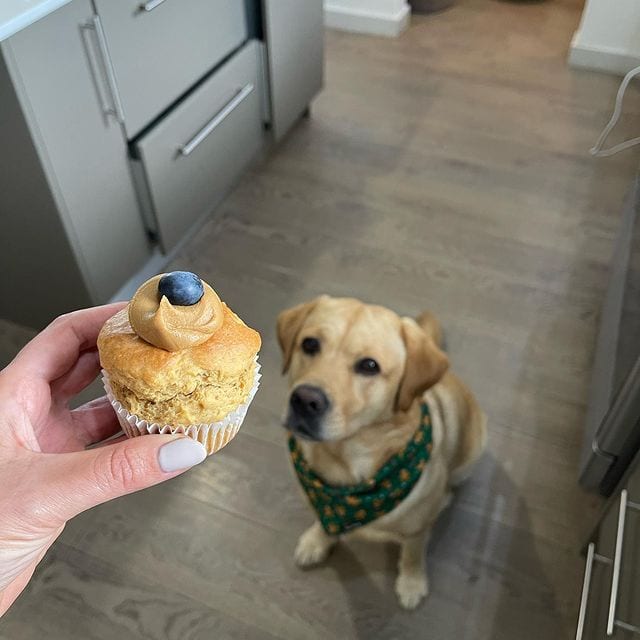
No, cupcakes aren’t okay for dogs. These popular birthday snacks contain a whole host of ingredients dangerous for dogs. The wheat, fat, and sugar present in these cakes are considered unsafe for canines.
Cupcakes are undeniably delicious. In fact, mentioning them is sometimes enough to get some of us salivating. They are just too tasty for anyone to resist. And best of all, they usually aren’t troublesome to our health. However, that’s not the case with our four-legged companions.
In the most basic form, a cupcake will come with wheat flour, sugar, milk, and butter. These four are the chief components in any cupcake recipe. Unfortunately, none of these ingredients is recommendable for dogs.
Can I Give My Dog A Chocolate Cupcake?
No, don’t give your dog a chocolate cupcake. Chocolate has caffeine and theobromine, all known to be poisonous to dogs. After ingestion, the two compounds will overstimulate the dog’s heart and the central nervous system.
Most of us love chocolate and want to enjoy it in nearly all home-baked snacks and desserts. And yes, it loves us back and even benefits our bodies in lots of ways. However, chocolate doesn’t replicate the same to dogs. It makes one of the worst enemies for pups.
So, what makes it dangerous for pups? Well, chocolate has methylxanthines, that is, caffeine and theobromine. Humans can metabolize these two chemicals well. However, dogs can’t, and that’s where all the trouble begins.
Whether eaten plain or coming in food, dogs can’t handle the caffeine and theobromine in chocolate. If they can’t be broken down and are foreign, then they aren’t safe to remain in the body. So, what happens is that the two compounds begin to trigger negative effects in the body, what now we refer to as chocolate poisoning.
Usually, the severity of chocolate poisoning will depend on the level of ingestion. However, in most cases, the smaller canines get the shorter end of the stick after eating chocolate. But again, no dog is immune to chocolate poisoning.
Can I Give My Dog A Vanilla Cupcake?
No, don’t give your dog a vanilla cupcake. Like any other type, vanilla cupcakes have significant amounts of sugar. And as we all know, sugar is unhealthy for dogs and should never feature in their diet.
Like chocolate cupcakes, vanilla cupcakes aren’t a good idea for dogs. Of course, the chocolate variety is more lethal to dogs. But that doesn’t make vanilla any good. Like the chocolate ones, vanilla cakes will compromise the wellbeing of your pup.
So, what causes the danger? You see, vanilla cupcakes contain an enormous amount of sugar. As such, when ingested, your dog could develop diarrhea, upset stomach, and other numerous side effects in the short term.
In the long term, sugar in vanilla cupcakes will make dogs gain weight. Conditions like pancreatitis and diabetes are also bound to happen. So yes, always avoid feeding your dog vanilla cupcakes just as much as you do chocolate cupcakes.
Why Is It Not Okay For My Dog To Eat Cupcakes?
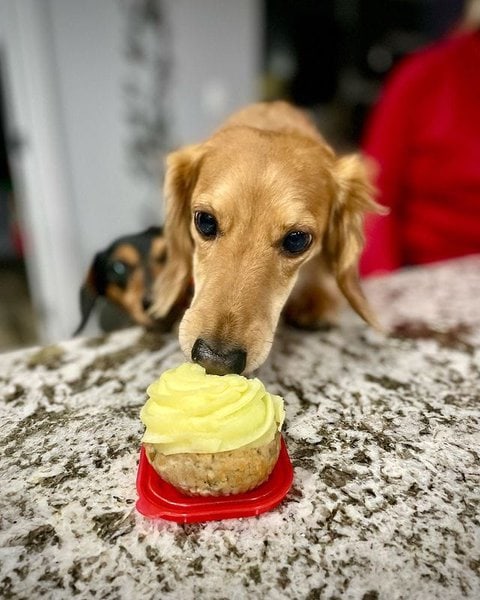
Cupcakes aren’t okay for dogs to eat because they come with dangerous ingredients for pups. The wheat, sugar, and dairy products, like butter and milk, in cupcakes all play a part in making cupcakes unsafe snacks for dogs. So yes, it’s all about what goes into these delicious cakes.
For instance, wheat contains gluten. That’s the same protein that gives wheat flour the elasticity, texture, and golden crust. In most cases, this protein isn’t harmful to humans. However, to dogs, it can cause numerous health effects.
You see, some dogs are gluten-intolerant. They could have this condition as early as at the point of birth. However, for some, gluten intolerance develops with time. But either way, gluten-intolerant dogs encounter problems when they eat anything containing wheat, for instance, cupcakes.
Again, some canines are allergic to wheat. In fact, this type of allergy is considered one of the most common food allergies for dogs. That could be another inlet to problems after dogs eat cupcakes. Unfortunately, you will never know that you have a dog allergic to wheat until they consume it.
Dogs with wheat allergies will develop skin irritation, ear infections, vomiting, or diarrhea after consuming anything made of wheat. Any of these signs means your dog has this type of allergy. And yes, that will be another reason not to give them cupcakes.
As for the dairy component, its consumption will often cause dogs issues. Pups are usually lactose intolerant, meaning they can’t digest anything containing milk.
However, puppies aren’t born that way, and that’s why they can digest their mother’s milk. As they age, dogs lose the ability to digest milk and eventually become lactose intolerant.
What Is In Cupcakes That Dogs Cannot Eat?
Cupcakes contain wheat, milk, chocolate, extracts, eggs, oil, and sugar. All of these ingredients are unhealthy for humans, leave alone dogs. When ingested, this blend of ingredients can cause stomach inflammation in dogs.
We share lots of similarities with dogs. However, we still differ on some grounds. A case in point is in the diet. Most of the foods we eat aren’t safe for dogs. That’s why most dog experts warn against feeding dogs human foods.
Now, nothing about cupcakes is healthy for dogs. In fact, most of the components aren’t healthy for you either. However, humans can handle these ingredients better than canines. That’s why you can safely eat cupcakes while pups can’t.
Certain cupcakes even come with artificial sweeteners in place of sugar, and it doesn’t make things any better. In most cases, the sugar-free cupcakes come with xylitol, which is highly dangerous to dogs, more so than sugar. In fact, most dog experts will tell you that xylitol is more lethal to dogs than chocolate!
What Happens If A Dog Eats A Cupcake?
What happens if a dog eats a cupcake has much to do with the ingredients in the cake. But you should at least expect the amount of sugar to cause vomiting and diarrhea depending on the amount of cake they eat.
Cupcakes come with different combinations of ingredients, some more dangerous than others. What will follow after your dog gobbles up a cupcake depends on what’s inside the cake.
Chocolate is one of the most dangerous ingredients a cupcake can have. This component is the second most dangerous component in cupcakes after xylitol. The adverse effects of chocolate can sometimes cause death. That’s why you should never take it lightly after your dog eats a chocolate-flavored cupcake.
A chocolate-flavored cupcake will make dogs exhibit signs of chocolate poisoning. They include but are not limited to;
- Hyperactivity
- Abnormal heart rhythms
- Restlessness
- Vomiting
- Increased thirst
- Elevated body temperature
- Increased blood pressure
- Increased thirst
- Tremors
Whether or not dogs will develop the above signs from chocolate cupcakes depends on how much chocolate is in the snack and how much of that snack the dog eats. In most cases, the trace amount of chocolate in one cupcake isn’t enough to cause dogs problems. But as the dog eats more cupcakes, the side effects become more likely.
But again, that will much depend on the individual dog’s reaction to chocolate. Some dogs will react to a smaller amount of chocolate intake than others, for instance, the pint-sized breeds and pups with underlying medical conditions.
Assuming that the cupcake doesn’t contain chocolate or xylitol, the remaining threat is from the chief ingredients. For instance, wheat can cause intestinal lining damage, especially for dogs suffering from celiac disease.
The milk component is a common cause of bloating in dogs once ingested. As said, dogs can’t digest dairy products, so anything containing milk will act as a laxative once it gets in the gut. That’s where bloating and other conditions like diarrhea come in.
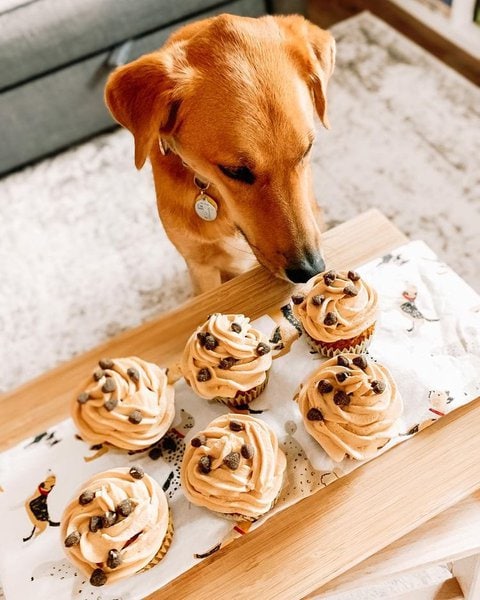
How Many Cupcakes Will Hurt Your Dog?
The level of harm cupcakes can hurt your dog depends on the composition of the cake. Some components like chocolate and xylitol in cupcakes are dangerous to dogs in tiny bits. Hence, small amounts of cake containing such can be harmful to dogs.
While it is usually not about the amount of cake a dog eats, it is often about the amount and the kinds of toxic substances ending up in the dog’s body system. Without the hazardous ingredients, cupcakes aren’t likely to affect dogs. Issues could still sprout from other unhealthy components in the cake, but that’s very unlikely.
But we usually don’t include xylitol in home-baked cakes. That leaves chocolate as the only big problem in cupcakes. Even so, a tiny amount of chocolate in cupcakes is less likely to cause anything serious in dogs.
In other words, it’s unlikely that dogs will develop problems after they eat a small amount of these cakes. However, in large amounts, consequences become more likely. But again, that doesn’t mean it’s okay to give your canine a small piece of this cake.
What Should I Do If My Dog Ate Cupcakes?
If your dog ate cupcakes, monitor them closely or seek professional help if you suspect they could develop an issue from it. You can rely on the amount they took and the ingredients in the cake to determine the possibility of side effects.
As we’ve already pointed out, some ingredients pose a greater risk to dogs than others. As such, after your dog eats a cupcake, it’s always advisable to examine the components of the cake. At this point, find out whether the cake had chocolate or xylitol.
If the snack didn’t have any of these ingredients, severe consequences are less likely. But still, go on and examine the amount of cake they ate. A larger quantity means that the side effects are more likely.
Ensure that you monitor your dog for any signs. If they have to develop anything from it, it will have much to do with diarrhea, vomiting, and other digestive issues. But that isn’t cast in stone as dogs don’t all respond the same way to something.
However, most of the likely side effects will resolve on their own. However, where you don’t notice any improvement after several days, it’s best to seek professional assistance.
If your dog is allergic to wheat, or anything in the snack, it’s again best to call the vet after they eat cupcakes – whether there are signs or not. Food allergies can be fatal in dogs and should never be taken lightly.
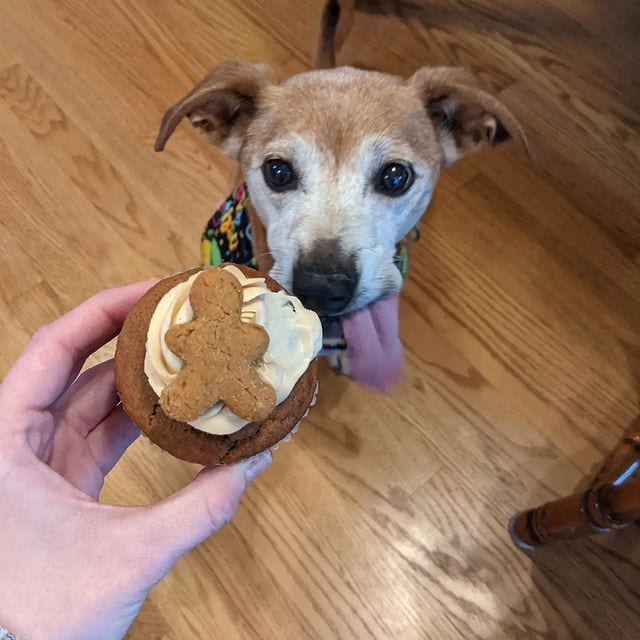
What If My Dog Ate Chocolate Cupcakes?
If your dog ate chocolate cupcakes, contact a licensed vet immediately. Chocolate could cause your dog havoc after ingestion. Letting the vet know that your dog ate it will allow you to handle the situation from a professional point of view right from the outset.
But before you chat with the vet, gather all the information they could need. For instance, find out what amount of cake the dog ate, the type of chocolate, and its load in the cake.
As much as chocolate is generally toxic to dogs, different types have different toxicity levels. For instance, cupcakes containing cocoa powder are likely to cause more severe issues in dogs than those coming with milk chocolate.
Where the snack contained other dangerous ingredients, do inform the vet. You can consider giving the dog doctor the entire list of ingredients if you aren’t sure about what’s harmful to your dog and what’s not.
The vet may ask you to monitor the dog for signs or carry them into the clinic depending on their assessed level of risk.
Treatment may involve inducing vomiting, especially where ingestion happened not longer than two hours ago. The health professional may then offer activated charcoal to help clear any traces of chocolate remaining in the body.
Where the case seems so severe, supplemental treatment could be necessary. Here, the vet may offer IV fluids and other more sophisticated treatment mechanisms to help get things back to normal.

